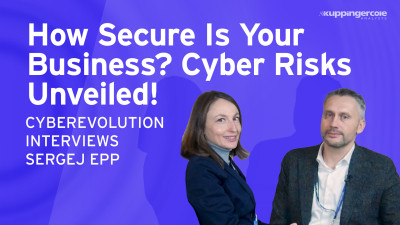Thank you so much, everybody. Good morning. It's yeah. Hi everybody. Lovely to join you even remotely. Appreciate all of you joining today. I am Donna Bethlehem, as I was noted. I'm head of product marketing. Kira tells and today's presentation is actually going to focus a lot on how we should be changing our ways in order to really prepare for the next compelling event, which are actually enrolling quite rapidly in our it environments and how to best make sure that we are set and, and ready to thrive and not merely survive. As many organizations have experienced over the past year and a half.
Thanks Donna. You already did my job, so I okay.
Oh, I'm sorry. I don't have anything more to add, jump in.
I'm
Sorry. Let's get started over to you.
Okay. Well then I pretty much introduced myself and I'll just carry on then. Yeah.
So, you know, if anything, over the past year and a half has shown us that the bill, that the ability of organizations to adapt will actually define which organizations and which companies will survive and thrive rather than just merely exist or struggle in the near future. Now, our research tele does an annual research on identity and access management authentication practices. And our research research shows that two thirds of enterprises actually expect continued work from home that will remain in place over the next for over the foreseeable future.
And it's really interesting actually, because today I'm presenting to you remotely. And if you would've asked, Lee asked me a month ago, whether I would be with you in the hall, I would probably said yes, but what we're definitely seeing is this pandemic is taking us through kind of a rollercoaster experience.
And from week to week and month to month is really very difficult to anticipate how organizations are going to be able to resume. I would say quote unquote, normal work practices that we had before the pandemic.
And it it's pretty unexpected the way that things are, are actually rolling out. And so I think that the norm will be either a very hybrid mode. So many workers choosing to, to work from home, some coming in infrequently into the office. But I don't think we'll ever see a resumption of the way that we are working before, where employees just came into the office every day.
What we're also seeing is that a larger and more diverse and more complex user base requires a remote access to data and applications.
This is given and all this is happening as the attack surface and sophistication increases and regulations continue adding potential liability to our work environment. The previous speaker from cyber also mentioned this and at many companies and organizations, remote workers are going or currently still going through the firewall or the VPN to access on premises apps and also perhaps some cloud applications. So you have complex architectures that are not necessarily effective for good streamlined and secure remote access.
So, you know, we can't be fully confident that all applications are secured at the login point and all have authentication enforced in a way that would protect organizations. So when we have customer discussions, it never ceases to surprise us that authentication is in place and policy based authentication and access management is in place for some applications, but definitely not for all. And this creates loopholes and we're going to discuss today, you know, what is the best way to address those, those loopholes?
Now, you know, there is broad recognition that one of the problems that organizations are facing is that there's no longer a defined security parameter. I mentioned in my previous slide, that many organizations are funneling their users through the VPN or through on-premises gateways in order to access cloud applications. But organizations are very much faced with this realization. And with this reality that there's no longer a defined security parameter. And that means that there's, you know, very no, no longer concrete different parameter to, to, to protect actually.
And this means that we all have to redefine remote access and secure remote access for our employees, especially in the given environment. Now, leading organizations are finding ways to accommodate increasingly complex user populations in this multi-cloud and hybrid cloud environment. And what we're seeing is that it professionals are really learning that it's very imperative to control all apps in a common security environment, try and plug those authentication loopholes that I mentioned before.
You need to AC separate your access security from your service provider will go into that in a bit more detail later on this presentation. And it's really, it's really important to also create control over your users and to be able to generate a good audit trail for compliance purposes.
And definitely one of the clearest conclusions that we're seeing in today's reality is that it's evident from the challenges that have that many organizations are facing and have faced over the past year and a half is that the, the status quo is not really an option anymore, right?
Especially not for those organizations that want to thrive that want to develop that want to succeed. And although many organizations have adjusted some perhaps at, in an ad hoc way and some better than others to the mass worker from home reality, we see that the, there are always unexpected events that are evident on and kind of present themselves at our doorstep. And these create disruption that require further adjustment one example just from the past six months. And this is of course, a, a direct, an indirect result of the pandemic is that we're facing a huge microchip for shortage, right?
This means that organizations that rely on hardware components, perhaps even for authentication purposes, are gonna be facing, are going to have to readjust and figure out how they're going to handle this micro, micro shortage, another compelling event. Well, not a really compelling event, but unexpected event that many organizations are going to have to figure out is and will cause them to readjust and to reassess their access management policies is the fact that Microsoft, for example, just last month increased significantly increased its prices for all of their ad packages.
So there are office 365 and Microsoft 365 packages. And I mentioned before that one of the important things is to be able to really maintain control of your access security. It's not only for security reasons, but it's also to maintain commercial agility. So those are just two events that show us that you always have to be with your face looking forward and thinking about the next steps and not really have in order to, instead of just having to scramble and cope with events as they hit you.
So in this spirit, how can organizations really be resilient without creating massive disruption and without breaking the bank? Because of course, cost is always something that we have to be fully aware of. For example, I mentioned that Tellus does an annual research project of access identity and access management practices.
This is a global research and we discovered, and one of the, the, the data points that were uncovered earlier on this year is that 250 senior it and risk executives in, in a recent market research that we did of those two 50 respondents, 85% actually stated that they prefer strategy of maintaining a hybrid environment and integrating and integrating with what, with the systems that they already have rather than ripping and replacing.
So, you know, some vendors are promoting, promoting a cloud, only reality move all of your users into the cloud, but actually in reality, that's the harder road to tread because it means actually displacing what you, what organizations have invested in for, for many, many years. And this is actually one of the factors that, and complex factors that organizations are facing.
They need to be able to build on existing investments and ultimately the preference for a more incremental phased approach into the cloud and into zero trust starts off by plugging authentication, authentication gaps as the best road to, to access to a modern access management approach.
And we'll discuss now, what are those key capabilities that will allow organizations to take this phased approach and build on what they already have in the organization, but really achieve a very good security footprint by taking this authentication everywhere approach and making sure that you don't have any loopholes access loop loopholes. So, you know, recent attacks show that there are risks in having all of your eggs in one basket, the ability to separate your access security from your data and applications will really help prevent lateral attacks across your environment.
Reduce the attack surface. We already heard in the previous presentation that this is becoming a very serious problem, and this will also ensure that you're able to address the rapidly changing regulatory landscape as shown by the shrimp's two ruling. The regular, the regulatory regime was pretty much upended and organizations are still figuring out how to address those regulatory requirements.
Now it's unclear in this regards really unclear how service providers will respond if required to hand over data.
So, yeah, so organizations are still, you know, need to take proactive approaches to that regulatory challenge, but, you know, when you separate your access security and your authentication from your service provider, at least you can ensure that the access to that data is in your hands and you have control over it. And also from a business perspective, committing to bundled services and a bundled business model will actually tie your hands for future and limit your ability to negotiate better commercial terms. So you basically very much locked into an existing model.
As I mentioned before,
Again, I'm referring back to the research that we did. This is it's interesting because it's research that was done on among leading it professionals, it executives and security executives.
And again, 89% of respondents said that the key me metric for measuring the success of an authentication and access management implementation is actually reduction of data breaches relating to secure, to remote access. So ultimately at the end of the day, access management and authentication are there to protect environments and to reduce the threat of data breach to organizations.
Now, not all access management solutions are created equal. The recent wave of the, the recent waves of severe attacks and data breaches really do show how important it is to go beyond merely ticking a box, especially when it comes to effective authentication mechanisms. And it's therefore important to look or out for some key capabilities that can help you achieve success in reducing data breaches with effective authentication.
So, first of all, you really wanna look out for strong and broad authentication methods that can be applied in a differentiated way. Just having one method of authentication for all of your users is not gonna do the trick you need to be. You need to be sure that admins and maybe C levels and higher privileged users have stronger mechanisms of authentication. You need solution. That's built with security at core.
So really partner with respected security vendor and make sure that even beyond the authentication mechanism that you're using, the actual solution is developed with highly secure capabilities embedded. So for example, the use of HSMs to secure cloud backends software tokens, for example, that can't be cloned or copied from one device to another software authenticators that are encrypted when provisioned all of these additional security mechanisms already help protect your users and your applications.
And of course, you need to ensure that you control your own access security, because this will help mitigate the risk of lateral attacks. It'll help mitigate the risk of inherited attacks that could potentially derive from a service provider. So ultimately organizations really need to meet budget constraints.
And again, the use of cloud based authentication is the best way to reduce costs. You also wanna make sure that the sec, the solution you select is very flexible and can, can be implemented very quickly and ensure quick return on investment and quick go to market.
Now just very quickly, because I know that we're coming up at the end of the presentation. This is actually an access management and authentication model that was promoted in a recent paper by ne it basically places the role of authentication and policy based access at the core of it security.
And in this model, you can see that various feeds and various circumstances are fed into an access management engine, which actually arbitrates all of the external signals and enforces the right level of authentication as needed. So this is really the, the blueprint for a modern access management authentication solution in organizations that want to plug authentication gaps, but also apply differentiated access policies to different types of users.
So coming up to the end of our presentation, Tellus, we're a huge security vendor, very well respected.
You'd actually be very surprised to know that TEUs solutions are at the heart of many of the daily digital and online services that we use. When you download an app from the app store, it's protected by tele solutions. When you log into, when you go through airport security, for example, when you and and airplane takes off. All of these things that we take for granted are actually secured by highly sophisticated tele security solutions. And we are here to work with you on your journey toward modern access management and authentication. Feel free to contact me by LinkedIn or by email.
And we're happy to have the consulted free consultation workshop with you to assess your current needs and understand how we can help you plug those authentication gaps. Thank you so much.

















































